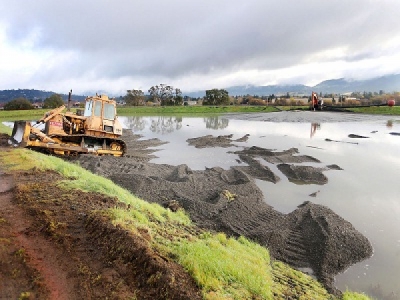
Posted on December 1, 2016
By Howard Yune, Napa Valley Register
As the clock runs down on a federal effort to create a deeper, safer Napa River for boating, authorities are seeking an extra 15 days to complete the project.
A state-imposed deadline requires the U.S. Army Corps of Engineers to wind up its excavation on a 17-mile river stretch from downtown Napa to Vallejo by Wednesday. However, a delay in getting the dredging contractor back to Napa from another project in Fort Bragg – as well as mechanical problems encountered in the waters near the city center – have led to an effort to seek state permission to work as late as Dec. 15, according to Rick Thomasser, operations manager for the Napa County Flood Control and Water Conservation District.
Much of the slowdown is related to large rocks and old tires in the river that have stalled or slowed excavating equipment near downtown, at the northern limit of the river’s shipping channel, Thomasser said Monday.
The debris may include not only worn-out tires discarded in the river and rocks washed from upstream, but also material that originally was used to shored up riverbeds only to be loosened with time and water currents, he added.
The delays have led the Corps’ contractor, Alaska-based Ahtna Design-Build Inc., to shift dredging work farther south, from the Jack’s Bend area near the Napa Valley Yacht Club to a point south of the Kennedy Park boat ramp.
Ahtna originally began its Napa River work in late September but then shifted its equipment north to clear the port of Fort Bragg, where the state environmental deadline for in-water excavation was Oct. 31.
The Corps’ state-issued excavation permit currently bars any work after Nov. 30, to avoid interfering with seasonal fish migrations in the Napa River. Any request for more dredging time would require approval from a partnership of state and regional authorities, including the Department of Fish and Wildlife and the San Francisco Bay Conservation and Development Commission, according to Thomasser.
Bay Area waterway excavations are capped at 50,000 cubic yards of material during each post-November off-season, and the Napa River project must compete with two others for that allowance, said Thomasser.
“If we get the (extra) time, we shouldn’t be volume-limited,” he said. “It’s really about the time.”
Using a barge-like vessel equipped with pumps, anchor poles, a cutter head and pipes, workers break up sediment on various parts of the river bottom, then deposit the spoils at two sites – one near the South Napa Century Center on Imola Avenue and another on the future Napa Pipe development site further south near Highway 29’s Butler Bridge.
Source: Napa Valley Register





